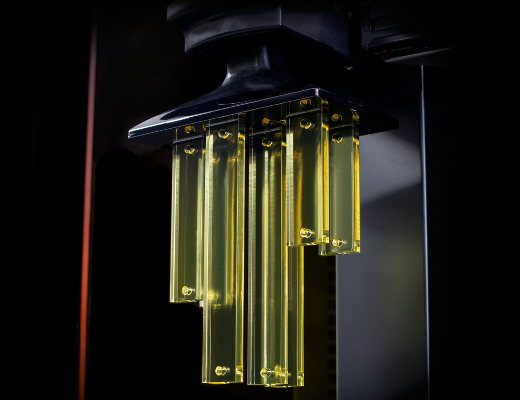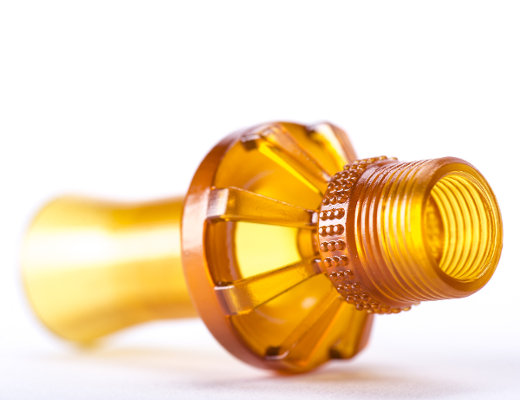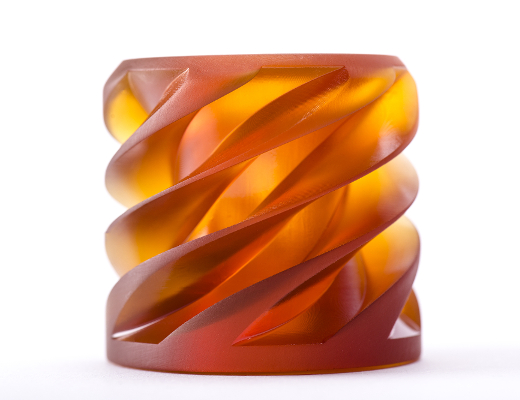3D Printing with Carbon’s Cyanate Ester: the complete Q&A
Posted By Jess Hedstrom on Jun 1, 2016 | 0 comments
Over the past 10 weeks, we’ve had the opportunity to use the new Carbon3D M1 digital light projector (DLP) resin-based 3D printer. Not only is the M1 printer the fastest in its category (stereolithography (SLA) printers), it also is compatible with a wide range of materials. In this blog series we will share our expertise on the Carbon 3D M1 resins. After the 1st post on Rigid Polyurethane the second article will focus on the most technical Carbon’s resin: Cyanate Ester (CE).
What does the Cyanate Ester Resin look like?
Cyanate Ester is an amber translucent resin. When cured it has a smooth and shinny surface (it really compares to the surface of a Polyjet print for instance). The surface becomes matte when you polish it. Depending on the orientation of the model when you are 3D printing, you can see sometimes very thin layers that are not strictly speaking machine layers. These are instead more artifacts coming from the process and don’t mean a fragility on the part. Because of the transparency of the material, it’s easier to notice on Cyanate Ester 3D prints.
What kind of pieces is the Cyanate Ester Resin really good for?
The Cyanate Ester-based resin is a high-performance material with heat deflection temperatures up to 219°C [426°F]. Marked by excellent strength, stiffness and long-term thermal stability, CE is useful for under-the-hood applications, electronics, and industrial components. We recommend to use Cyanate Ester for 3D printing functional and end-use parts that need to keep their strength in hot environments.
Carbon has published a very interesting video where you can see how Cyanate Ester behaves in a forced circulation heated oven. The prototyping acrylate resin is included as a comparison. Each bar is suspended between two anchors with a 200 gram weight on its center point. As the temperature increases, each material behaves according to its properties. The prototyping acrylate resin gradually deforms, bows and break, while the bar of CE continues to support the weight.
This material is already used for production by some of our pilot customers for tooling and mechanical parts in automotive and aeronautics industries.
How precise is the Cyanate Ester Resin 3D print?
The M1 3D Printer can print at very high resolution. Features as thin as 0.25 mm can be 3D printed in Cyanate Ester and will be rigid.
Can I print moving parts with the Cyanate Ester Resin?
In theory, you could, but it really depends on your 3D model. Cyanate Ester as any CLIP resin needs to be supported during the prints. That means that we need to support any moving parts and depending on the geometry it can be very difficult to remove the support. We have printed the Sculpteo logo for instance without any problem, but the clearance is tremendous. It’s too early for us to know what is the perfect minimum clearance requested that’s why we don’t offer interlocking parts option on any CLIP resin so far.
How does the 3D printer work?
When you upload your 3D file on Sculpteo.com, we take care of your file by repairing it if needed and preparing it for the selected 3D printer. The M1 3D Printing is using CLIP technology. CLIP, which stands for Continuous Liquid Interface Production, eliminates shortcomings of other 3D printing technology by emphasizing a tunable photochemical process over a traditional mechanical approach.
Regarding Cyane Ester, CLIP process is paired with a secondary curing stage to unlock engineering properties. Traditional additive approaches to photopolymerization typically produce weak, brittle parts. Carbon overcomes this by embedding a second heat-activated reactive chemistry in our materials. This results in high-resolution parts with engineering-grade mechanical properties.
How much does it cost to 3D print with the M1 3D printer?
Prices vary depending on the size of your object and the amount of material needed to print it (density of your object). When you upload your file on Sculpteo.com, you get a confidential real-time price quote. You can then adjust your file to change the price.
How should I prepare my file for a 3D print in Cyanate Ester resin?
3D models can be prepared similarly as for SLS printers, with one exception. If a design has an enclosed hollow region, the liquid resin will be permanently trapped within the cavity. To avoid this, designs for the M1 3D printer should include an opening to allow drainage of the excess uncured resin from hollow regions. As with other DLP 3D printers, the M1 printer will create supports for overhang regions that will be removed later. For efficient support removal during part cleanup, try to design your part such that areas that need support are accessible!
What kind of finishing can I get?
We offer 2 types of finishing for Cyanate Ester on the website
- Raw : we cut the supports
- Hand polished: we manually sand and polish the part in order to remove any support scar.
The CLIP resins are still in a testing phase, but we will release them really soon. If you would like to 3D print in Cyanate Ester you still need to register to the CLIP Pilot Program. We explain you everything here. If you have any other question regarding Cyanate Ester resin and CLIP technology, don’t hesitate to contact us.


 Connect with Google
Connect with Google Connect with Facebook
Connect with Facebook

